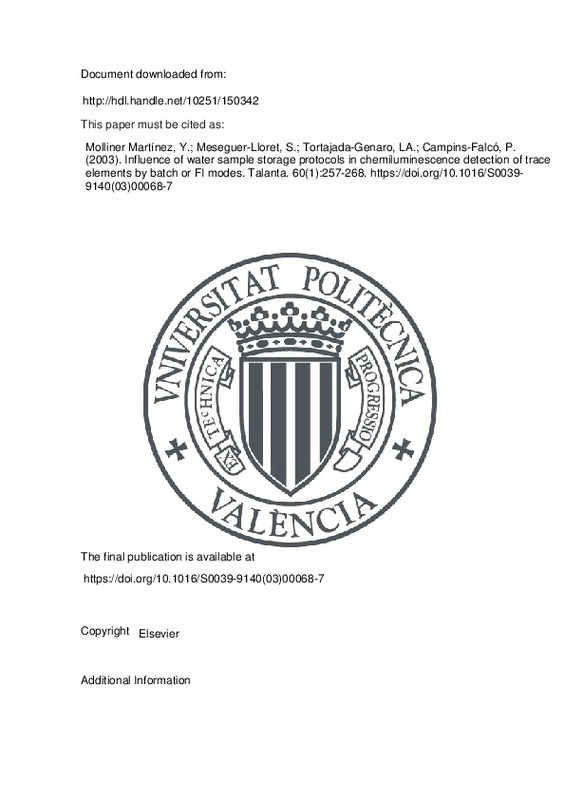JavaScript is disabled for your browser. Some features of this site may not work without it.
Buscar en RiuNet
Listar
Mi cuenta
Estadísticas
Ayuda RiuNet
Admin. UPV
Influence of water sample storage protocols in chemiluminescence detection of trace elements by batch or FI modes
Mostrar el registro sencillo del ítem
Ficheros en el ítem
| dc.contributor.author | Molliner Martínez, Y.
|
es_ES |
| dc.contributor.author | Meseguer-Lloret, S.
|
es_ES |
| dc.contributor.author | Tortajada-Genaro, Luis Antonio
|
es_ES |
| dc.contributor.author | Campins-Falcó, P.
|
es_ES |
| dc.date.accessioned | 2020-09-18T03:35:48Z | |
| dc.date.available | 2020-09-18T03:35:48Z | |
| dc.date.issued | 2003-03-12 | es_ES |
| dc.identifier.issn | 0039-9140 | es_ES |
| dc.identifier.uri | http://hdl.handle.net/10251/150342 | |
| dc.description.abstract | [EN] This paper shows the influence of different sample storage protocols, on the chemiluminescence signal of some metal ions. The storage protocols studied were: acid addition (HCl or HNO3) and no reagent addition to filtered and refrigerated (T=4 °C) samples. Light emission was produced for the chemiluminescence reaction between luminol and hydrogen peroxide in buffer carbonate conditions (pH 10.8) catalysed by Cr(III), Co(II) and Cu(II). Batch and/or flow modes in different conditions were tested. Fe(II), Fe(III), Ni(II) and Mn(II) did not give chemiluminescence in the studied conditions. A parallel study of sensitivity and selectivity was performed. Then the presence or absence of the masking agent EDTA, added to samples or used in the carrier stream, is assayed. If the samples are acidified with HNO3, a previous neutralisation is needed using batch mode. The determination of Cr(III) is independent of storage protocol by flow injection (FI) method; however, the determination of Co(II) or Cu(II) or total determination of three metals requires the conditioning of standards. Detection limits achieved are ranged between 0.5 and 2 ¿g l¿1. For batch mode, detection limits are better for unacidified samples and worse for carbonate-neutralised samples. The influence of storage protocols was validated using standard metal mixtures and calibration solutions. The use of standard reference material (SRM© 1640) (Trace elements in natural water) corroborates the previous statements and validates the accuracy of the different approaches underlined. This paper demonstrates that it is possible to determine Cr(III) selectively in natural waters. | es_ES |
| dc.description.sponsorship | The authors are grateful to the DGICYT (Project No. PB 97-1387) for financial support. Y.M.M., S.M.L. and L.A.T.G. express their gratitude to Ministerio de Educación y Cultura (Spain) for the predoctoral grant. | es_ES |
| dc.language | Inglés | es_ES |
| dc.publisher | Elsevier | es_ES |
| dc.relation.ispartof | Talanta | es_ES |
| dc.rights | Reconocimiento - No comercial - Sin obra derivada (by-nc-nd) | es_ES |
| dc.subject | Chemiluminescence | es_ES |
| dc.subject | Metal determination | |
| dc.subject | Storage protocols | |
| dc.subject | Luminol hydrogen peroxide reaction | |
| dc.subject.classification | QUIMICA ANALITICA | es_ES |
| dc.title | Influence of water sample storage protocols in chemiluminescence detection of trace elements by batch or FI modes | es_ES |
| dc.type | Artículo | es_ES |
| dc.identifier.doi | 10.1016/S0039-9140(03)00068-7 | es_ES |
| dc.relation.projectID | info:eu-repo/grantAgreement/MECD//PB97-1387/ | es_ES |
| dc.rights.accessRights | Abierto | es_ES |
| dc.contributor.affiliation | Universitat Politècnica de València. Departamento de Química - Departament de Química | es_ES |
| dc.description.bibliographicCitation | Molliner Martínez, Y.; Meseguer-Lloret, S.; Tortajada-Genaro, LA.; Campins-Falcó, P. (2003). Influence of water sample storage protocols in chemiluminescence detection of trace elements by batch or FI modes. Talanta. 60(1):257-268. https://doi.org/10.1016/S0039-9140(03)00068-7 | es_ES |
| dc.description.accrualMethod | S | es_ES |
| dc.relation.publisherversion | https://doi.org/10.1016/S0039-9140(03)00068-7 | es_ES |
| dc.description.upvformatpinicio | 257 | es_ES |
| dc.description.upvformatpfin | 268 | es_ES |
| dc.type.version | info:eu-repo/semantics/publishedVersion | es_ES |
| dc.description.volume | 60 | es_ES |
| dc.description.issue | 1 | es_ES |
| dc.relation.pasarela | S\28508 | es_ES |
| dc.contributor.funder | Ministerio de Educación y Cultura | es_ES |







![[Cerrado]](/themes/UPV/images/candado.png)

